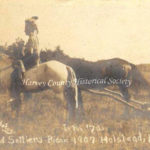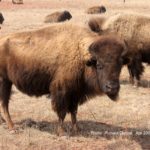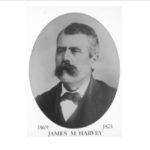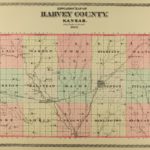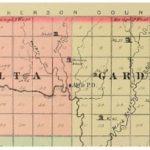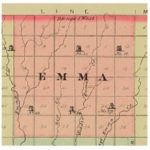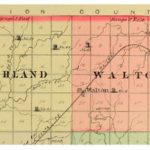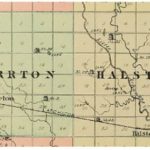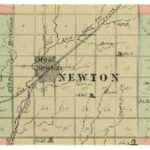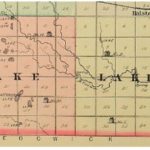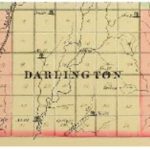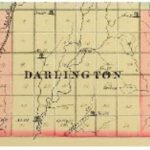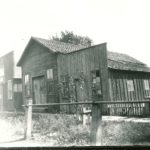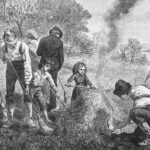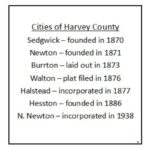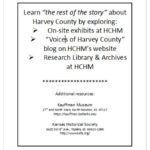Organization and Continued Settlement of Harvey County, Kansas
The birth and early years of Harvey County were somewhat difficult and contentious due to instances of fraud, bribery, payoffs, corruption, voter irregularities, fierce rivalries and panderings to people’s egos. The organization and continued settlement of Harvey County encompassed a number of transitions, challenges, and issues.
A plan to create a new county from townships in Sedgwick, McPherson and Marion Counties came when Newton’s Republican representatives to a Sedgwick County political convention were snubbed. They came back to Newton determined to form their own county with Newton as the county seat. The plan passed the Kansas Legislature on February 29, 1872. The county was named for James M. Harvey, Kansas Governor. Along with other events and happenings, these political maneuverings were instrumental in the formation of Harvey County.
Through on-line exhibits, this slideshow series gives short stories about Harvey County and its cities; and provides a sampling of the stories which can be discovered by viewing the on-site exhibits at HCHM, by examining source material in the Research Library and by utilizing the HCHM photo collection.
For even more stories of Harvey County’s people, events and businesses, check out:
- The HCHM blog, “Voices of Harvey County” on the About Us tab.
- The Story of Alta Mill. A business of yesteryear that made flour and feed, it was an industry situated in Alta Twp of northwest Harvey County. Additionally, Alta Mill was a community center due to its park in the nearby woods along the banks of the Little Arkansas River. Within the park were picnic grounds and a camping area plus access to fishing, boating and swimming. These features attracted the farming families who utilized the mill for grinding their grain. Alta Mill played a key role in the lives of people from the communities of Burrton, Halstead, Moundridge and Buhler. For many groups from Newton, Hutchinson, and other communities, Alta Mill became a favorite spot due to the recreational activities. By clicking http://www.altamill.org/, the detailed story of Alta Mill can be learned. (Note: By going to the link, you’ll leave the HCHM website.)
Check the website regularly for the addition of new on-line slideshows in this series on Harvey County, Kansas.
Click anywhere on the first image below to scroll through Unit 5 — Organization and Continued Settlement of Harvey County, Kansas.
- Click this slide to start Unit Five on “Organization and Continued Settlement of Harvey County.”
- “No Sign of Human Habitation” was a fallacy in Euro-American minds. Major transitions in the 1860s through the 1880s brought an end to “the old way of life.” This time period of transformation was earmarked with an upheaval of peoples, lifestyles, economies and environment. The “old way of life” era was characterized by Native Americans, buffalo (bison) and unbroken prairie stretching from horizon to horizon. Located just across the Little Arkansas River from Alta Mill in northwest Harvey County was a Native American village. It was identified by the General Land Office surveyors, giving evidence “Kaw Indians” (actually Quivira/Wichita) were living there in 1860. The photo shown above is marked “In the ’70s” (i.e. the 1870s) which is indicative of the presence of Native Americans in the area of Harvey County. In spite of evidence and the facts, a fallacy existed in the minds of many Euro-Americans. They believed the Great Plains had “no sign of human habitation.” Photo from HCHM collection.
- Judge R.W.P. Muse reported on his travels during 1870 through the future Harvey County, “…large herds of buffalo were found in the western portion…. In fact buffalo meat was the principal diet at every house and ranch in the county….” The Newton Kansan of Sept 5, 1872 reported, “Fine herds of buffalo are now ranging within forty-five miles of Wichita.” An article in the July 17, 1873 edition of the Newton Kansan said, “Several farmers in the west part of the county are preparing to go out on a buffalo hunt in a few days, and others have already gone.” The era came to an end in 1874. Judge Muse reported, “The last buffalo killed in the county was in 1874, in the Prouty neighborhood, in Macon Township.” Photo: Ronald Dietzel, April 2008.
- Until early 1872, Sedgwick County included the towns of Newton and Sedgwick. Because Newton had both the railroad and Texas cattle business, a fierce rivalry developed between Wichita and Newton. 1871 was a pivotal year when, in October, talk surfaced about the formation of a new county. Both Wichita and Newton favored the plan of a new county since it rid each town of its rival. Added into the mix was tension between Wichita and Park City as well as competition between the towns of Sedgwick and Newton. Named in honor of James M. Harvey, Governor of Kansas (1869 – 1873), Harvey County was organized by an Act of the Kansas legislature on February 29, 1872; and was completed in 1873 with an annexation from Marion County.
- Harvey County was created from portions of Sedgwick, McPherson, and Marion Counties. The original plan was to form the new county out of the surrounding counties by taking ten northern townships from Sedgwick County, three townships from southeast McPherson County, and two townships from southwest Marion County. In February 1872, the bill was passed into law with only thirteen townships in the new county since the Marion County representative refused to support the new county unless the two Marion County townships were withdrawn from the plan. The story then evolved into political payoffs when a Marion County legislature candidate promised to help Harvey County get Walton Twp from Marion County in return for help in getting elected. The city of Peabody, hoping to start their own county, opposed the move. Both groups raised funds to support their positions (i.e. the buying of Senate votes). Senate members accepted bribes from both factions. The bill to annex Walton Twp to Harvey County passed on March 6, 1873 by one vote. A motion to reconsider was tabled until after the dinner hour. When the Senate adjourned for dinner, the committee who favored annexation rushed the bill to Governor Harvey, who signed it immediately.
- Alta Township was secured from McPherson County. Each township in the new Harvey County received its name for a reason. Alta is one of four townships with a name chosen to honor or memorialize an individual. Alta was the name of the deceased daughter* of Judge R.W.P. Muse, an early settler and prominent figure in the establishment of Harvey County. Located in Alta Twp was the now non-existent settlement of Alta and the site of Alta Mill. In the early years, a post office called Valentine served the community from a small office in the Alta Mill. Later, the post office’s name was changed to Alta. Alta and Garden Townships were originally settled by several French and Irish families who homesteaded on the Little Arkansas River and at the mouth of Turkey Creek in the fall of 1869 or the spring of 1870. *Note: Alta Olivia Muse was born 17 Aug 1847 in Ohio. She graduated from high school in 1866, married Josiah Sinclair of Pittsburgh, PA in 1869 and, at the age of twenty three, died in February of 1871 after a few months of failing health. Alta’s father, Judge R.W.P. Muse, arrived at the townsite for Newton in May of 1871 with the objective of opening a land office. When Harvey County was created in 1872, the memory of Alta and her death would have been fresh in Judge Muse’s mind. As a result, it seems only natural that he’d name something after her. Image from Edward’s Map of 1882.
- Garden Township was obtained from McPherson County. Garden is one of five townships with a name chosen as a descriptor of their area. After Harvey County was established, a large number of Mennonite Christian families homesteaded most of the remaining government land* while other Mennonite Christians purchased large tracts of railroad land* in the Township. Located in Garden Twp was the now non-existent settlement of Garden City, at which a post office was established in 1872. Like Alta Twp, Garden Twp was originally settled by several French and Irish families who homesteaded on the Little Arkansas River and at the mouth of Turkey Creek in the fall of 1869 or the spring of 1870. *Note: As the federal government appropriated the lands of the Great Plains during the mid 1800s, Congress felt it had the right to make a distribution of the lands since many Euro-Americans believed the area was “empty and uninhabited.” As a result, large tracts of land were earmarked as government owned. It was made available to the “head of household” under the stipulations of the Homestead Act of 1862. At the same time, the U.S. government earmarked millions of acres as railroad owned. This land was made available as land grants to the railroad industry. The railroads then sold much of the land as a way to create revenue which financed the building of the railways. In the areas where there was both government and railroad land, the acreage’s designation was determined in an every-other-section (a section is one mile by one mile) format in a checkerboard pattern. Land sales were handled through separate government land offices and railroad land offices. Image from Edward’s Map of 1882.
- Emma Township was acquired from McPherson County. Emma was named after three like-named creeks which run through it. It is thought the creeks were named after the young daughter of an immigrant family. When she fell ill and died, she was buried beside the creek. Due to the tragedy of her early death, the creeks were named after the immigrant girl—resulting in West Emma, Middle Emma, and East Emma. Within the boundaries of Emma Twp are the City of Hesston and the site of the now non-existent village of Zimmerdale (originally named Trousdale). Image from Edward’s Map of 1882.
- Highland and Walton Townships were annexed from Marion County. When annexed into Harvey County in 1873, this area was all a single township. In January of 1876, a petition was presented to the Harvey County Commission asking that Walton Twp be divided into two townships. Approval was given so the west half became Highland Twp and the east half became Walton Twp. The first settlement of the area was in the spring of 1871 with entries being made in the Augusta land office. The completion of the Santa Fe railway line from Emporia to Newton in July of 1871 contributed greatly to the settlement of the area. Wood for fuel was hauled from the Little Arkansas River near Sedgwick and the Whitewater River in Richland Twp. Lumber, food, and other supplies were brought in on the train. Highland Twp’s name was chosen as a descriptor of the area. Located in this township was the now non-existent community of Eleanor, at which a post office was established in 1883. Walton Twp is one of four townships which was named in appreciation of the Santa Fe Railway’s efforts to build the area. Walton was named for a Santa Fe stockholder. Within the boundaries of Walton Twp are the City of Walton and the site of the now non-existent community of Braddock. Image from Edward’s Map of 1882.
- Burrton and Halstead Townships were secured from Sedgwick County. Burrton Twp was named in appreciation of the Santa Fe Railway’s efforts to build the area. Originally known as Valley Twp, it was renamed to honor I.T. Burr, Vice President of the Santa Fe Railway. The original settlers arrived in April, 1871. In September of the same year, a large group of Welsh homesteaded most of the land just east of the city of Burrton. Halstead Twp was named after Murat Halstead, a Civil War correspondent and editor of the Cincinnati Commercial Historian. Within the boundaries of Halstead Twp is the City of Halstead. Image from Edward’s Map of 1882.
- Macon, Newton, and Pleasant Townships were obtained from Sedgwick County. Macon Twp is one of two townships named after the former home of an early settler. However, it’s unclear if the name was for someone’s former home in Macon County, Illinois; or, in honor of early settler Samuel Sarvey’s hometown in Michigan. Newton Twp’s name was chosen in appreciation of the Santa Fe Railway’s efforts to build the area. The name comes from Newton, Massachusetts—the Boston suburb which was home to many Santa Fe stockholders. Within the boundaries of Newton Twp are the City of Newton, the City of North Newton and the site of the now non-existent community of Goldschaar. Pleasant Twp’s name was chosen as a descriptor of the area. Located within Pleasant Twp was the now non-existent community of Sheldon, at which a post office was established in 1871. Image from Edward’s Map of 1882.
- Lake and Lakin Townships were acquired from Sedgwick County. Lake Twp’s name was chosen as a descriptor of the area. In the township is Patterson Lake, the only natural lake in Harvey County. Located within Lake Twp was the now non-existent town of Patterson, at which a post office was established in 1888; and the now non-existent community of Egypt. Lakin Twp, a township receiving its name in appreciation of the Santa Fe Railway’s efforts to build the area, was the namesake of D.L. Lakin, an early land commissioner for Santa Fe Railway. The homestead filings during the rush from 1871 to 1872 contained so many fraudulent entries that accurate information about Lakin Township’s settlement was impossible. Lakin Twp was the second to establish a school. Image from Edward’s Map of 1882.
- Sedgwick Township was secured from Sedgwick County. Sedgwick Twp was named for Maj. Gen. John M. Sedgwick of the U.S. Army. Per a Newton Kansan article in December 1896, this township can lay claim to several Harvey County firsts—the first birth (Rosa M., daughter of Chas. Schaefer, on Aug. 12, 1870), the first male birth (Henry, son of P.M. Morgan on Feb. 13, 1871), the first school house in 1870, and the first death in 1870 by shooting. Within this township are the majority of the City of Sedgwick, the remainder being in Sedgwick County, and the site of the now non-existent community of Putnam, at which a post office was established in 1891. Image from Edward’s Map of 1882.
- Darlington and Richland Townships were obtained from Sedgwick County. Darlington Twp, one of the townships named after the former home of an early settler, was named for the county seat of LaFayette County, Wisconsin. Judge Muse reported the first frame structure in Newton was that of a building moved there from Darlington Twp in about March 1871. The now non-existent village of McLain (also called McLains), at which a post office was established in 1886, was located at the corners of Darlington, Richland, Newton and Pleasant Twps. Richland Twp’s name was chosen as a descriptor of the area. Early township residents of note were Dr. Sylvester Foster, the first physician in Harvey County. A Mr. Johnson was the county’s first probate judge. Within the boundaries of Richland Twp was the now non-existent town of Annelly, at which a post office was established in 1885. Image from Edward’s Map of 1882.
- Three very early businesses in Newton – Exact addresses and types of business are unknown. The birth and early years of Harvey County were tumultuous and stormy. Following the formation of the new county, a county seat needed to be selected—a designation desired by both Sedgwick and Newton. In May of 1872, the issue was put to a vote but the results were problematic. Per Judge Muse, Sedgwick Twp had 125 legal voters and the poll books showed over 700 votes were cast. In Newton Twp, at least 100 more votes were cast than the number of legal voters in the township. At the end of the day, Newton was selected. The “Dark Period” of Harvey County’s history is Judge Muse’s phrase for the time between the county’s organization and the Fall of 1875. Census records went missing. Important papers disappeared. Meeting minutes of the County Commissioners were kept imperfectly or entirely omitted. There were charges that a “Tweed Ring” had been formed in some of the county offices—with large sums of money being wrongfully issued. Photo from HCHM collection.
- Clearing a field of grasshoppers. The “Good Old Days” were difficult. A great wind and rain storm damaged parts of Harvey County in June of 1871. Judge Muse wrote about an October 1871 calamity in which “a very severe and cold storm of hail, sleet and snow passed over Harvey County…hundreds of cattle in all parts of the county perished….” The grasshopper plague of 1874 impacted the prairies from the Dakotas to Texas. Judge Muse reported the arrival of the insects in Harvey County in August. Huge swarms blocked out the sun. They ate crops, paper, tree bark, and wooden tool handles. Muse said this was the County’s second grasshopper invasion with the first occurring in 1860. During the 1874 “scourge,” the grasshoppers ate or destroyed within two or three weeks every stalk of corn and all green vegetation in Harvey County. An economic crisis occurred in 1873. From the late 1880s to the early 1890s, farmers experienced a series of difficult years due to droughts and the resulting crop failures. For a number of years, the political and social climate of the county had an undercurrent of jealousy and resentment since hard feelings festered in Burrton, Halstead and Sedgwick over Newton’s designation as county seat. The three smaller towns felt they were underserved due to Newton’s size giving it more clout. Credit: Kansas Historical Society. http://www.kshs.org/kansapedia/grasshopper-plague-of-1874/12070
- The towns and cities of Harvey County which survived into the 21st century. During the 145+ years since its creation, Harvey County has seen the birth, rise and demise of numerous communities. “Sometimes all that is left is a photograph of a group of children or an obscure mention in a history book, but Harvey County can count at least 17 lost towns since 1871. Some were only on the map for a year or two, boasting a post office and maybe a blacksmith shop. Others, like Annelly, were the site of a school long after the post office and other services had disappeared. Several, like Alta Mill and Zimmerdale, were once thriving, if small, communities. The reasons for their disappearance vary.” – Kristine Schmucker, Curator, HCHM; Jan 23, 2015. The list of vanished communities includes Alta (also called Valentine and Alta Mill) in Alta Twp; Annelly in Richland Twp; Braddock and Doyle in Walton Twp; Darlington (unknown location but likely in Darlington Twp); Eleanor in Highland Twp; Garden City in Garden Twp; Goldschaar in Newton Twp; Fairview (with its post office at Hillside Farm) and Paxton in Halstead Twp; McLain (also called McLains) in the corners of Pleasant, Newton, Darlington and Richland Twps; Patterson and Egypt in Lake Twp; Putnam in Sedgwick Twp; Sheldon in Pleasant Twp; and Trousdale (later called Zimmerdale) in Emma Twp.
- This pictorial history unit about Harvey County was compiled by Ronald Dietzel. Acknowledgement – Through their input and suggestions, Kristine Schmucker (HCHM Curator) and Jane Jones (HCHM Archivist) made significant contributions to the compilation of this unit. Click over to Unit 6 “Agriculture in Harvey County: Part of the ‘Wheat State’ Story” in the on-line series of “Short Stories of Harvey County.”



